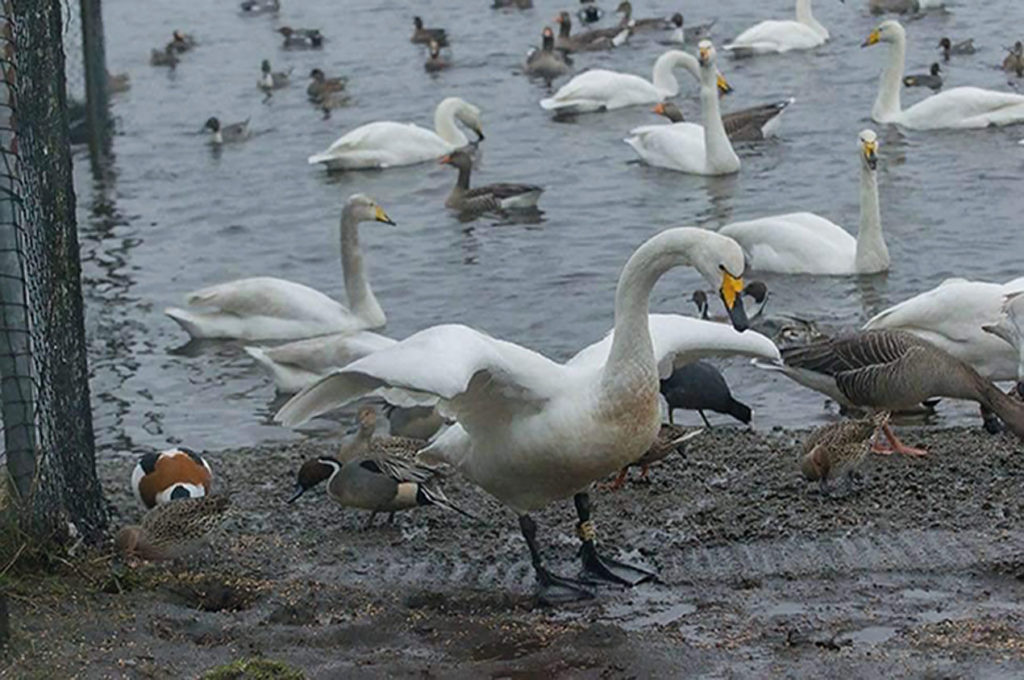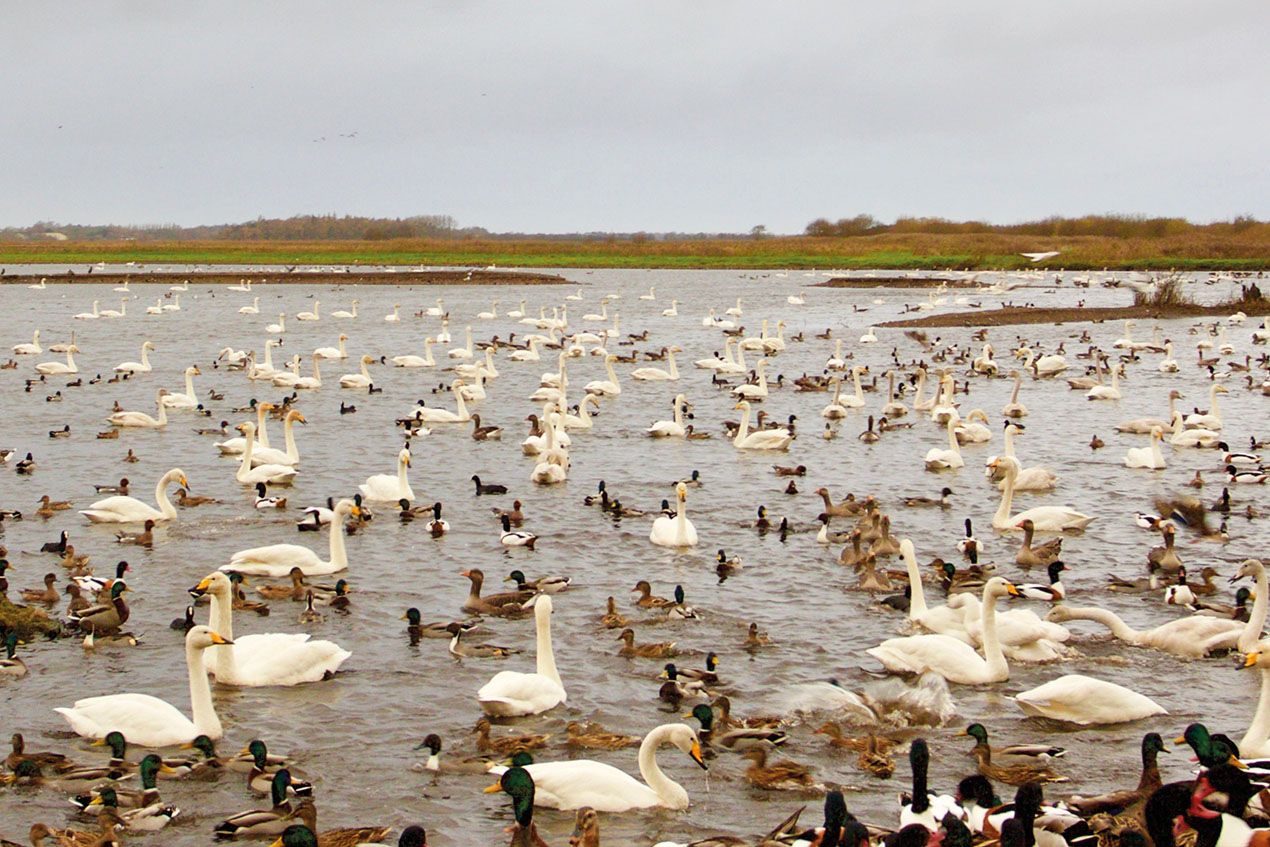Swans around
Lancashire’s Martin Mere was once bigger than Windermere. After the area was drained for farming, what remained became a veritable swan lake
Virginia is 27 years old and already on her third husband. She divides her time between summers in Iceland and winters in Lancashire, where she has become a bit of a local celebrity. In the next couple of weeks – perhaps by the time you read this – Virginia will head south to England.
She’ll be accompanied by some of her children, which at the last count were said to total more than 60. Whether she has now moved on to husband number four is news that’s awaited with more than a little interest.
“Virgina’s second husband is still alive. We think they got separated during migration.”
“I know – all this sounds like something out of EastEnders,” laughs Louise Clewley, standing on the shore of Martin Mere, the focal point of a 600-acre nature reserve run by the Wildfowl and Wetland Trust 10 miles inland from Southport. Behind her, a small number of swans are mingling with several hundred ducks. These are not the familiar mute swans with bright orange bills that are found on every park lake and pond in Britain, but whooper swans. This species has a striking yellow and black bill and tends to congregate in huge flocks. Virginia is Martin Mere’s best-known whooper swan, and satellite tags fitted to others in her flock will tell Clewley when she is on her way back to Lancashire.
By mid-November there will be more than 2,000 whoopers on or around the 10-acre lake, forming one of the biggest wildlife spectacles in the north of England. It is also – by some distance – the region’s noisiest gathering of birds. The swans are named after their loud “whooping”, which beats the decibel level of any other British species and is constantly emitted while the swans are on the lake. Incredibly, these calls are used to maintain bonds between parents and their cygnets when they become separated in huge flocks.
Clewley, the reserve’s manager, logged the first whooper arrivals from Iceland on 28 September. Within a week they numbered just 32, all of them either non-breeding birds or failed breeders, the simple evidence being that none was accompanied by cygnets. It is usually mid-October when the first family parties begin to arrive.
Their annual flight south from the breeding grounds on Iceland’s north, west and south coasts to spend the winter at Martin Mere is remarkable. The whooper is a real whopper, one of the largest flying birds in the world, with a wing span of eight feet. It can manage the 700-mile journey in just 14 hours, flying at such a high altitude that an aircraft pilot who happened to be a birdwatcher once reported coming across a flock at 8,000 feet.
Clewley says: “It’s amazing to think that the cygnets which hatched in those Icelandic nests back in June and July are capable of flying here in October.”
The satellite tags show their flight path takes them south over the Atlantic Ocean to Harris and Lewis in the Western Isles, where some of them stop to feed. Others use the Inner Hebrides islands of Coll and Tiree to refuel. The last stopping point before Martin Mere is often on the Scottish side of the Solway Firth.

Each pair of swans fledges up to seven cygnets in the breeding season, and when they are brought to Martin Mere their plumage is greyish and they have yet to acquire the bright yellow colouring on their bills. Once there, the staff and volunteer wardens at the reserve start checking the swans with binoculars and telescopes for rings on their legs, which through an ingenious mixture of colours and easily legible letters and numerals can identify each bird’s breeding and migration history.
These so-called field-readable rings are made from light plastic and are used only on larger birds. Over a dozen clearly defined colours are used, and in conjunction with different coloured lettering an infinite amount of combinations are available to single out a specific bird. In the case of Virginia, her leg ring is yellow, and the conspicuous letters VJA in black easily identify her among the world’s population of 185,000 whooper swans. In the main bird hide at Martin Mere there is a touch screen where visitors can simply enter VJA on a virtual keyboard and learn her life history. For example, it says that since she was ringed in 1993 she has flown a total of 8,100 miles, and her current partner’s leg ring – also yellow – is identifiable by the code F6B.
It’s always a relief when Virginia’s return is confirmed, because 27 is a grand old age for a whooper swan. The average lifespan is nine years, although Clewley says that one or two have lived until the age of 30.
Virginia doesn’t only spend time at Martin Mere on her winter visits. She is often recorded at the Wildfowl and Wetland Trust’s reserves at Caerlaverock near Dumfries, and Welney in the Norfolk fens. “Really, Virginia should be a member of the Trust to get her full money’s worth when she visits these sites,” Clewley jokes. “Actually, we know a lot about her now. For instance, her second husband is still alive. We think they got separated during migration. They didn’t realise that the other had survived, and it was a real surprise for us to see them both at Martin Mere the following year, each with new partners. But it must’ve been an even bigger surprise for them when they met again on the lake. And I love the fact that Virginia has found herself a much younger male.”
After a period of decline whoopers are showing an increase in their fortunes. An important factor has been conservation work at their nesting grounds in Iceland, where the whooper is known as the Álft. When the adults return from the UK to begin breeding again they are usually still accompanied by their cygnets from the previous year. They often have to chase them away from the new nest, sometimes leading to fights between parents and their young.
A worrying threat to whooper survival, though, is the high number of cases of lead poisoning in the UK, the cumulative effect of ingesting spent gunshot on fields where wildfowlers are legally allowed to shoot ducks and geese – although on wetlands non-toxic steel alloy shot is now used. At least 2,000 tonnes of the toxic shot pellets – equalling two million bags of sugar in weight – is discharged at live quarry in Britain every year, most of it left on the ground.
The swans mistake it for seed or think it is grit, which they need to grind up food in their crops since they have no teeth. Lead is a very soft metal and when dissolved can get into their bloodstream. When Clewley and her team find dead birds and send them off for a post-mortem a significant number have lead poisoning.
The other main hazard is power lines, and at the moment five whoopers with broken wings which were found near pylons are being treated at Martin Mere. Foxes attempt to stalk the whoopers when they are on the ground but a simple flap of the wings is enough to scare them off. Occasionally an otter is seen killing a swan, however.
About a quarter of the UK’s wintering whoopers population is found at Martin Mere, and it’s easy to understand why they return. Each winter they are provided with tons of potatoes that are below supermarket quality. In harder weather they fly off over the flat farmland of west Lancashire and follow tractors engaged in the potato harvest, eating any that are not picked up. And on Martin Mere itself they are fed wheat twice a day. The food is scattered around the apron and shallow water in front of the viewing hides. Their 3pm feed has become a popular event with visitors but it has a more serious role for Clewley. It allows her and her staff to get a close look at the swans’ leg rings and record which old friends have come back to Martin Mere. “If we’re lucky this year, Virginia will once again be among them.”
WWT Martin Mere is signposted off the A59 near Burscough in Lancashire (wwt.org.uk)

Leave a reply
Your email address will not be published.